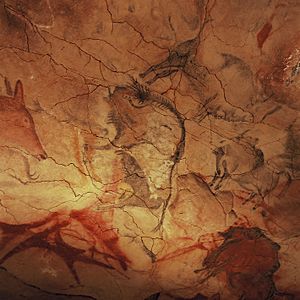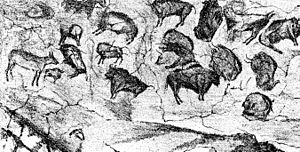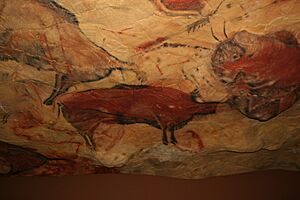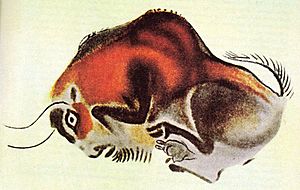Cave of Altamira facts for kids
|
Cueva de Altamira
|
|
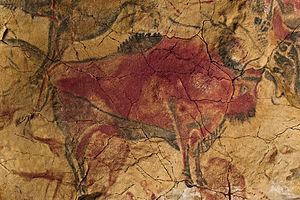
Magdalenian polychrome bison
|
|
| Location | Santillana del Mar (Cantabria), Spain |
|---|---|
| Coordinates | 43°22′57″N 4°7′13″W / 43.38250°N 4.12028°W |
| Type | Cave painting |
| History | |
| Periods | Aurignacian–Magdalenian |
| Site notes | |
| Discovered | 1868 |
| Official name: Cave of Altamira | |
| Type: | Cultural |
| Criteria: | i, iii |
| Designated: | 1985 (9th session) |
| Part of: | Cave of Altamira and Paleolithic Cave Art of Northern Spain |
| Reference #: | 310-001 |
| Region: | Europe and North America |
| Buffer zone: | 16 ha (0.062 sq mi) |
| Official name: Cueva de Altamira | |
| Type: | Non-movable |
| Criteria: | Monument |
| Designated: | 25 April 1924 |
| Reference #: | RI-51-0000266 |
The Cave of Altamira ( AL-tə-MEER-ə; Spanish: Cueva de Altamira) is a famous cave complex in Spain. It is located near the town of Santillana del Mar in Cantabria. This cave is known for its amazing cave art. These paintings show animals and human hands. They were made using charcoal and different colored paints.
The oldest paintings in the cave are from the Upper Paleolithic period. This was about 36,000 years ago. Modesto Cubillas first found the site in 1868. Later, Marcelino Sanz de Sautuola studied it more closely.
Altamira is famous for two main reasons. First, its colorful art is truly stunning. Second, it was the first place in Europe where cave paintings were proven to be from prehistoric times. Sautuola shared his findings in 1880. Many people were excited at first.
However, some experts did not believe that ancient humans could create such art. They thought the paintings were too good. This argument lasted until 1902. By then, similar old paintings were found in other caves nearby. This new evidence proved that Altamira's art was indeed prehistoric.
Altamira is part of the Franco-Cantabrian region. In 1985, UNESCO named it a World Heritage Site. It is a key part of the Cave of Altamira and Paleolithic Cave Art of Northern Spain. To protect the art, you can no longer visit the real cave. But there are excellent copies of the cave and its paintings that you can see.
Contents
What is the Cave of Altamira like?
The Altamira cave is about 1,000 meters (3,280 feet) long. It has many winding passages and rooms. The main path is between two and six meters (6.5 to 20 feet) high. The cave formed naturally from changes in the rock over time.
Scientists have dug up many old tools and items from the cave floor. These items are from the Upper Solutrean period (about 18,500 years ago). They are also from the Lower Magdalenian period (about 16,590 to 14,000 years ago). Both of these times are part of the Paleolithic or Old Stone Age. For about 2,000 years between these periods, only wild animals lived in the cave.
The people who lived here had plenty of food. They could hunt animals in the nearby valleys. They also found seafood from the coast. Around 13,000 years ago, rocks fell and blocked the cave entrance. This kept the cave's contents safe until it was found again. The discovery happened when a tree fell and moved some of the rocks.
People only lived near the cave's entrance. But the artists created paintings throughout the cave. They used charcoal and colored minerals like ochre or hematite. They often mixed these colors with water to make different shades. This made the images look more real and three-dimensional. The artists also used the natural bumps and curves of the cave walls. This helped make their subjects look like they were popping out.
The most amazing part is the Polychrome Ceiling. It shows a group of extinct steppe bison. These bison are in different poses. There are also two horses, a large doe, and maybe a wild boar.
These famous paintings were made during the Magdalenian period. They include both animal pictures and abstract shapes. Paintings from the Solutrean period show horses and goats. There are also handprints. Artists made these by placing their hands on the wall. Then they blew paint over them, leaving a negative image. Many other caves in northern Spain have ancient art. But Altamira is known for being the most detailed and having the most art.
How was Altamira discovered?
In 1879, Marcelino Sanz de Sautuola visited the cave. His eight-year-old daughter, María, was with him. She was the one who first noticed the drawings on the walls. Sautuola, an amateur archaeologist, quickly realized these were ancient drawings.
Sautuola and archaeologist Juan Vilanova y Piera studied the cave. In 1880, they published their findings. They said the paintings were from the Paleolithic Age. At first, many people were excited.
However, some French experts strongly disagreed. They thought the paintings were too advanced for ancient humans. They even made fun of Sautuola's findings at a meeting in Lisbon in 1880.
Because the art was so good, some people even accused Sautuola of faking it. They wondered why there were no smoke marks on the cave walls. Sautuola later learned that ancient artists might have used animal fat for their lamps. This would produce much less smoke than other fuels.
It took until 1902 for the scientific community to change their minds. By then, more ancient paintings had been found in other caves. This made the idea of very old art in Altamira seem more believable. That year, a famous expert named Émile Cartailhac admitted his mistake. He wrote an article called "Mea culpa d'un sceptique" (My fault, a skeptic). Sadly, Sautuola had died 14 years earlier. He never got to see his work fully accepted.
Later, Cartailhac wrote books about the cave. He was helped by Henri Breuil, who drew copies of the paintings. Breuil was a priest and a skilled artist.
Other archaeologists also worked in the cave. These included Hermilio Alcalde del Río (1902-1904), Hugo Obermaier (1924-1925), and Joaquín González Echegaray (1968).
How old are the Altamira paintings?
Scientists are still working to figure out the exact age of the art in Altamira. There is no single agreement on the dates.
In 2008, researchers used a special method called uranium-thorium dating. They found that the paintings were made over a very long time. This period could have been as long as 20,000 years. This was much longer than people first thought.
A study in 2012 used more dating research. It showed that some symbols in Altamira's "Great Hall" were very old. The oldest symbol, a large red club-like shape, was dated to about 36,160 years ago. This means it was made during the Aurignacian period. A red outline of a horse was dated to about 22,110 years ago. This shows that the paintings were created over more than 10,000 years.
Can you visit the Altamira Cave?
In the 1970s and 2000s, many visitors came to the cave. Their breath, with carbon dioxide and water vapour, started to damage the paintings. Because of this, the real Altamira cave was completely closed in 1977. It reopened with very limited access in 1982. Only a few visitors were allowed each day. This led to a three-year waiting list!
In 2002, green mold started to grow on some paintings. So, the caves were closed to the public again.
To let people still see the amazing art, a copy of the cave was built nearby. The replica cave and museum opened in 2001. It was built by Manuel Franquelo and Sven Nebel. This copy lets you see the colorful paintings of the main hall. It also shows some smaller artworks and sculptures of human faces. These are not visible in the real cave.
Besides the museum in Spain, there are other copies of Altamira. You can find them in the National Archaeological Museum of Spain in Madrid. There's also one in the Deutsches Museum in Munich, Germany. And another copy was made in Japan.
In 2010, there were talks about reopening the real cave. But in December 2010, the Spanish Ministry of Culture decided to keep it closed. Experts said that the cave's condition had become much more stable since it was closed. This decision helps protect the ancient art for the future.
How has Altamira influenced culture?
Some of Altamira's colorful paintings are very well known in Spanish culture. For example, the government of Cantabria uses a bison from the cave as its tourism logo. A Spanish cigarette brand from the 20th century, Bisonte, also used a Paleolithic bison image.
The Spanish comic series Altamiro de la Cueva started in 1965. It is named after the Altamira Cave. The comics show funny adventures of prehistoric cavemen. They are like modern people but dressed in fur, similar to the Flintstones.
The song "The Caves of Altamira" is on the 1976 album The Royal Scam by the band Steely Dan. The soul group Perri later covered this song.
A mid-20th-century dinnerware line called Primitive was designed by Viktor Schreckengost. It was based on the bison, deer, and stick figure hunters from the Altamira cave paintings.
The famous bison image has also been used on book covers. For example, it's on the poetry collection Songs for the Devil and Death by Scottish author Hal Duncan.
In the film Agantuk by Satyajit Ray, the main character is inspired by the charging bison painting. It makes him want to leave home and study tribal people.
In 2007, the Altamira caves were chosen as one of the 12 Treasures of Spain. This was a contest by Spanish TV and radio stations.
In 2016, British Director Hugh Hudson released a film called Altamira (or Finding Altamira). It tells the story of the cave's discovery. The film stars Antonio Banderas and has music by Mark Knopfler.
See also
 In Spanish: Cueva de Altamira para niños
In Spanish: Cueva de Altamira para niños
- 7742 Altamira, an asteroid named after the cave
- Art of the Upper Paleolithic
- Chauvet Cave
- Caves in Cantabria
- List of Stone Age art
- Paleolithic Cave Art of Northern Spain


